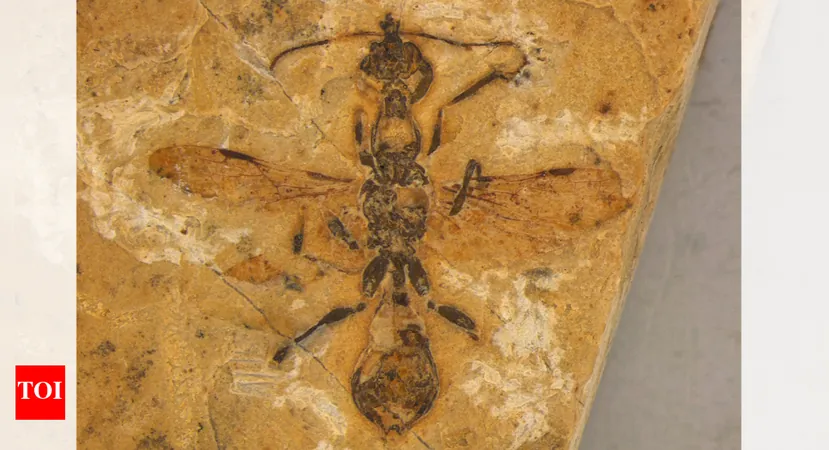
Unearthing the Ants of Doom: 113-Million-Year-Old Hell Ant Fossil Changes Everything
2025-04-25
Author: Wei
A Shocking Discovery in Brazil
In a stunning revelation, scientists in Brazil have unearthed the world’s oldest known ant fossil, dating back a jaw-dropping 113 million years! This fossil belongs to a fierce predator known as a 'hell ant,' and its discovery is redefining our understanding of ant evolution. Ants have been striding the Earth alongside dinosaurs, and this fossil showcases the remarkable complexity and specialized traits these insects possessed even in their primordial days.
Meet the Hell Ants: Nature's Ferocious Predators
Hell ants, scientifically classified as Haidomyrmecinae, roamed the Earth during the Cretaceous period, approximately 145 to 66 million years ago. What sets them apart is their terrifying jaw structure. Unlike modern ants that swing their jaws side to side, hell ants wield scythe-like jaws that curled upwards, ideal for impaling prey. This gruesome hunting technique has earned them the dramatic moniker of 'hell ants.' They're not just interesting; they represent some of the most anatomically unique ants in evolutionary history!
The Game-Changing Fossil: Vulcanidris cratensis
The newfound fossil is a winged female, likely a queen, found in limestone deposits in Brazil's Crato Formation. Named Vulcanidris cratensis—after the family that donated the rock and a common suffix in ant taxonomy—it predates the previously oldest ant specimens found in amber by around 13 million years. This fossil stands as a testament to the ancient lineage of ants, disrupting assumptions about when these creatures first appeared.
Decoding Fiery Hunting Techniques
Leading the charge in this research, Anderson Lepeco from the Museu de Zoologia da Universidade de São Paulo utilized cutting-edge 3D imaging, or micro-computed tomography, to delve into the fossil. This allowed scientists to explore the ant's intricate internal structures, particularly its fearsome jaws. When prey approached, the hell ant would strike quickly, snapping its jaws shut in a motion that pinned its victim, akin to stabbing meat with a fork—an evolutionary advantage that modern ants lack.
Ants: Marvels of Evolution
Ants are not just ancient relics; they're ecological powerhouses! With an estimated population of nearly 20 quadrillion, they're found across every continent except Antarctica—equating to about 2.5 million ants for every person on Earth. Their societies are complex, with remarkable communication skills and even medical practices, like amputating injured nestmates. Remarkably, some ants can be trained to use their incredible sense of smell to detect diseases such as cancer.
Why This Discovery is Groundbreaking
This fossil offers the earliest definitive evidence of ants in South America, pushing their presence on the continent back by over 60 million years! As Corentin Jouault, an evolutionary biologist from the University of Oxford, emphasizes, this is a significant leap in our understanding of ancient ants, suggesting they were pervasive during the era of Gondwana, the supercontinent that once united South America, Africa, and India.
What’s Next in the World of Ant Research?
The implications of this discovery extend far beyond just one fossil. Researchers are now eager to build a larger database of ancient ant specimens, contributing to the understanding of ant evolution. This remarkable find underscores the importance of museum collections, as the fossil was hidden away in rocks that had been overlooked for years. As scientists continue to explore underappreciated sites and collections, the thrilling saga of the hell ants reveals that many of Earth’s historical enigmas are still waiting for their moment in the spotlight.





 Brasil (PT)
Brasil (PT)
 Canada (EN)
Canada (EN)
 Chile (ES)
Chile (ES)
 Česko (CS)
Česko (CS)
 대한민국 (KO)
대한민국 (KO)
 España (ES)
España (ES)
 France (FR)
France (FR)
 Hong Kong (EN)
Hong Kong (EN)
 Italia (IT)
Italia (IT)
 日本 (JA)
日本 (JA)
 Magyarország (HU)
Magyarország (HU)
 Norge (NO)
Norge (NO)
 Polska (PL)
Polska (PL)
 Schweiz (DE)
Schweiz (DE)
 Singapore (EN)
Singapore (EN)
 Sverige (SV)
Sverige (SV)
 Suomi (FI)
Suomi (FI)
 Türkiye (TR)
Türkiye (TR)
 الإمارات العربية المتحدة (AR)
الإمارات العربية المتحدة (AR)